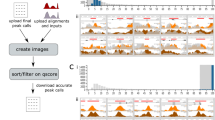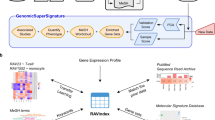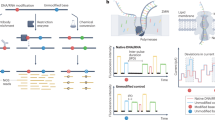Abstract
Genomic experiments produce multiple views of biological systems, among them are DNA sequence and copy number variation, and mRNA and protein abundance. Understanding these systems needs integrated bioinformatic analysis. Public databases such as Ensembl provide relationships and mappings between the relevant sets of probe and target molecules. However, the relationships can be biologically complex and the content of the databases is dynamic. We demonstrate how to use the computational environment R to integrate and jointly analyze experimental datasets, employing BioMart web services to provide the molecule mappings. We also discuss typical problems that are encountered in making gene-to-transcript–to-protein mappings. The approach provides a flexible, programmable and reproducible basis for state-of-the-art bioinformatic data integration.
This is a preview of subscription content, access via your institution
Access options
Subscribe to this journal
Receive 12 print issues and online access
$259.00 per year
only $21.58 per issue
Buy this article
- Purchase on SpringerLink
- Instant access to full article PDF
Prices may be subject to local taxes which are calculated during checkout







Similar content being viewed by others
References
R Development Core Team. R: A Language and Environment for Statistical Computing (R Foundation for Statistical Computing, Vienna, Austria, 2008) ISBN 3-900051-07-0.
Gentleman, R.C. et al. Bioconductor: open software development for computational biology and bioinformatics. Genome Biol. 5 (10): R80 (2004).
Kasprzyk, A. et al. Ensmart: a generic system for fast and flexible access to biological data. Genome Res. 14 (1): 160–169 (2004).
Hubbard, T.J. et al. Ensembl 2009. Nucleic Acids Res. 37 (Database issue): D690–D697 (2009).
Rogers, A. et al. Wormbase 2007. Nucleic Acids Res. 36 (Database issue): D612–D617 (2008).
Matthews, L. et al. Reactome knowledgebase of human biological pathways and processes. Nucleic Acids Res. 37 (Database issue): D619–D622 (2009).
Durinck, S. et al. BioMart and Bioconductor: a powerful link between biological databases and microarray data analysis. Bioinformatics 21, 3439–3440 (2005).
Durinck, S. Integrating biological data resources into R with biomaRt. The Newsletter of the R Project 6/5, 40–45 (2006).
Boutros, M. et al. Analysis of cell-based RNAi screens. Genome Biol. 7, R66 (2006).
Wei, J.S. et al. The MYCN oncogene is a direct target of miR-34a. Oncogene 27 (39): 5204–5213 (2008).
Hahne, F. et al. Bioconductor Case Studies. Springer Verlag, New York, USA, (2008).
Pruitt, K.D., Tatusova, T. & Maglott, D.R. NCBI reference sequence (RefSeq): a curated non-redundant sequence database of genomes, transcripts and proteins. Nucleic Acids Res. 35 (Database issue): D61–D65 (2007).
Bruford, E.A. et al. The HGNC database in 2008: a resource for the human genome. Nucleic Acids Res. 36 (Database issue): D445–D448 (2008).
Neve, R.M. et al. A collection of breast cancer cell lines for the study of functionally distinct cancer subtypes. Cancer Cell 10, 515–527 (2006).
Parkinson, H. et al. Arrayexpress update – from an archive of functional genomics experiments to the atlas of gene expression. Nucleic Acids Res. 37, D868–D872 (2009).
Irizarry, R.A. et al. Exploration, normalization, and summaries of high density oligonucleotide array probe level data. Biostatistics 4, 249–264 (2003).
Acknowledgements
We thank Arek Kasprzyk and Rhoda Kinsella for insightful discussions.
This work was partially funded by the U24 CA126551 grant.
Author information
Authors and Affiliations
Corresponding author
Supplementary information
Supplementary Data 1
Zip archive containing the raw data of the Neve et al. study on a panel of 51 breast cell lines. It consists of Affymetrix CEL files of gene expression measurements deposited in ArrayExpress as experiment E-TABM-157, and Array CGH and protein quantification data which are available from http://cancer.lbl.gov/breastcancer. (ZIP 168067 kb)
Rights and permissions
About this article
Cite this article
Durinck, S., Spellman, P., Birney, E. et al. Mapping identifiers for the integration of genomic datasets with the R/Bioconductor package biomaRt. Nat Protoc 4, 1184–1191 (2009). https://doi.org/10.1038/nprot.2009.97
Published:
Issue Date:
DOI: https://doi.org/10.1038/nprot.2009.97
This article is cited by
-
The synergism of cytosolic acidosis and reduced NAD+/NADH ratio is responsible for lactic acidosis-induced vascular smooth muscle cell impairment in sepsis
Journal of Biomedical Science (2024)
-
Pro-inflammatory feedback loops define immune responses to pathogenic Lentivirus infection
Genome Medicine (2024)
-
The role of microRNAs in understanding sex-based differences in Alzheimer’s disease
Biology of Sex Differences (2024)
-
Genes and pathways revealed by whole transcriptome analysis of milk derived bovine mammary epithelial cells after Escherichia coli challenge
Veterinary Research (2024)
-
Identification of three distinct cell populations for urate excretion in human kidneys
The Journal of Physiological Sciences (2024)



